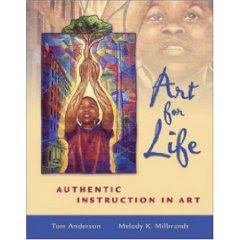Joni
Hough
November
6, 2013
Advanced
Art Education Methods
Review of Stinespring and Kennedy
In
the article, “Meeting the Need for Multiculturalism in the Art Classroom,” Stinespring
and Kennedy proclaim that postmodern critics complain that modernism is
discriminatory, and critics of postmodernism complain that it is too
inclusive. As teachers try to increase
the diversity in the art they present to students they often present the work
as “primitive, exotic, or quaint.” To
combat this Vesta Daniel has suggested six guidelines for teachers including
encouraging students to question traditional standards of excellence, including
art work from those who are disenfranchised, and connecting local interests to
art from around the world.
Stinespring and
Kennedy also suggest using current terminology when referring to groups of
people. They however, use the term
“black” to refer to African Americans.
They are ignoring their own advice.
Stinespring and
Kennedy offer the basic criteria for judging one’s art program as does the
curriculum reinforce Western exclusiveness or does it embrace and variety of
human expression. They also posit that
it matters less how many cultural groups are represented as long as those that
are taught are handled with respect. I
disagree with this statement because I believe it is important to include a
variety of cultures in the curriculum, and not just those cultures represented
in the student population.
Multiculturalism is important for all students, not just minority
students.
The
authors go on to suggest that it is important to teach about the context in
which the artist made his or her artwork so that students will understand the
struggles facing oppressed artists. They
further explain that it is important for African American students to learn
about African American artist because it helps raise the students’
self-esteem. I would argue that it is
just as critical for all students to learn to respect all cultures by learning
about a variety of cultural groups.
As
a sidebar, Stinespring and Kennedy include the story of African American
artist, Charles White. They discuss the
people who mentored him and who helped him overcome the oppression of being
African American in the early part of the twentieth century in the United
States. It is an interesting sidebar.






No comments:
Post a Comment